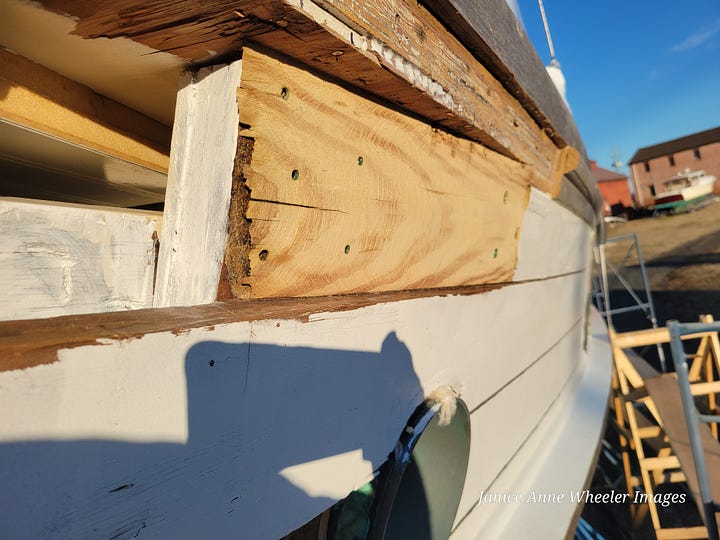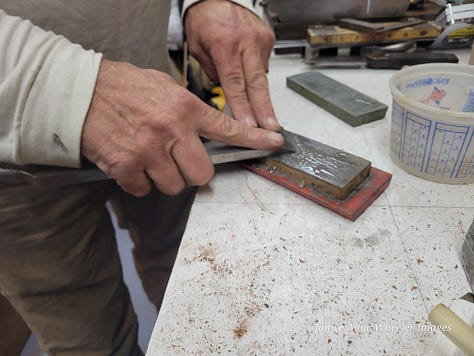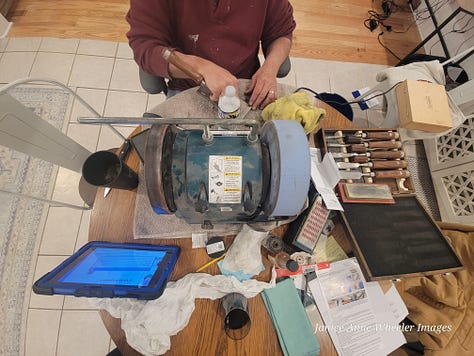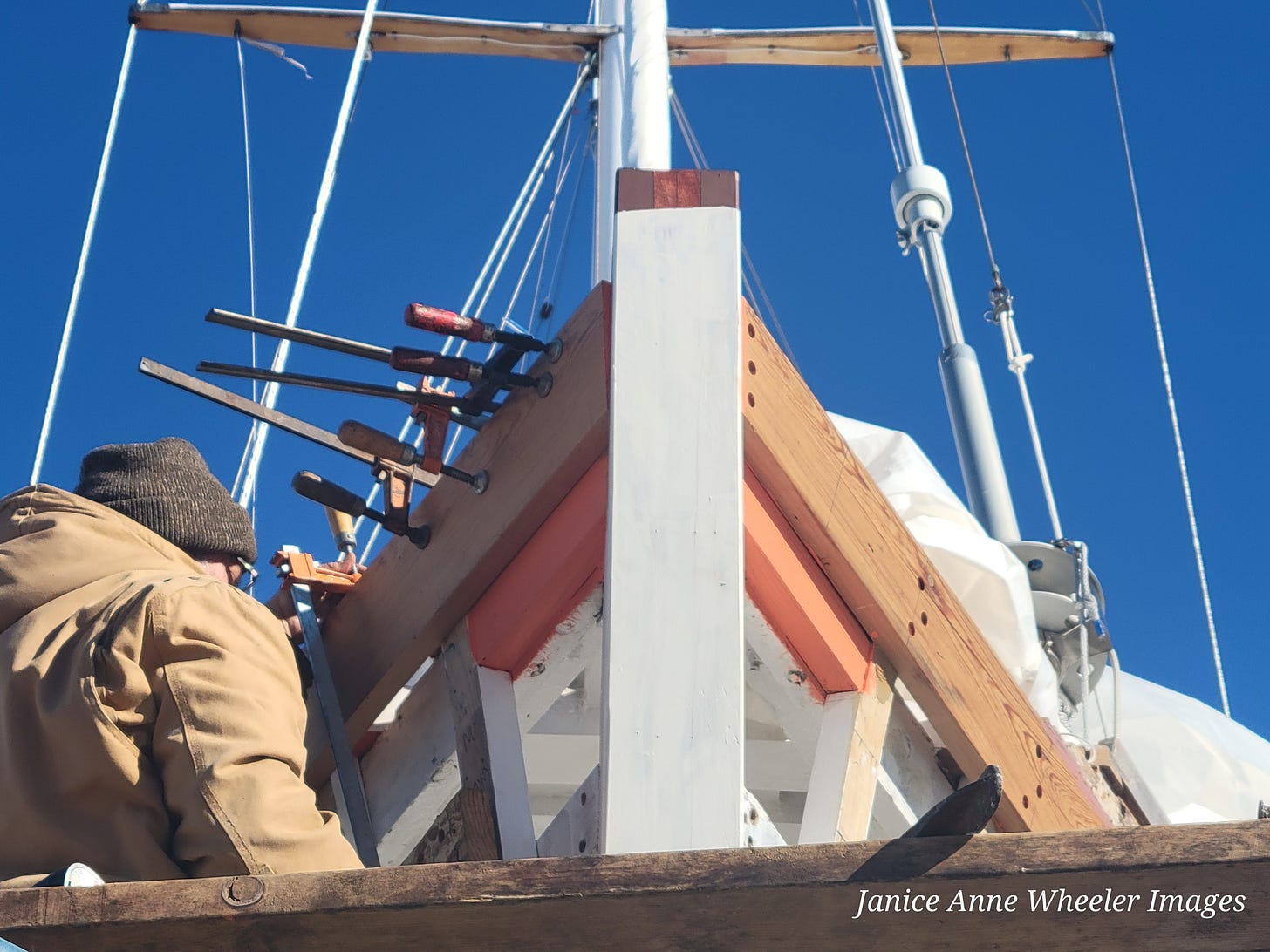Perhaps not what I’m referring to, unless you’re a woodworking aficionado, which some of you most certainly are, and most of you are not. Scarfing in my previous life was picking the one that best matched my outfit, and then arranging it just so. The term also came to mind when watching folks at a free happy hour buffet, for example. They definitely scarfed it. (And yes, happy hour snacks used to be free.)
Around here, we scarf grilled oysters and old-growth long leaf yellow pine planks. Those two acts are a considerable contrast. One is fast and delectable, the other meticulous and time-consuming.
When the planking phase of this repair first began, we were focused on two separate planks, one existing and one replacement, a particular angle, and many measurements that needed to meld, needed to become one in order to maintain the continuity and strength of the vessel. That connection, the joint between the pieces is called a scarf. We call the act of connecting the two scarfing, although that verb might be one of those that we created out of a noun without proper permission from the English language, if you know what I mean. No one seems to know where the term came from, even Google; their origin explanation seemed implausible, at best. Can any of you enlighten us on that? If so, I’d be interested. The origins of these things often surprise and entertain as well as educate.


In boatbuilding, scarf joints are used in a multitude of situations where boards simply aren’t long enough to build what needs to be built. Our teak toe rails (around the outside of the deck) are a great example; the long diagonal joints are barely even visible, they were so carefully created.
There are a tremendous amount of steps when scarfing new planks to old as we are doing for this project. These processes are culminations, really, and began months ago with determining which elements were still strong enough to keep and which needed to be replaced, the removal of the derelict wood and determining the scope of the repair, which was much more extensive than we had imagined.
We then began pulling the fasteners (sounds simple but actually a time-consuming undertaking with a bucket of tools, grit and patience), replacing the crucial structural elements that I have written about here. Months of work led to meticulously measuring, planing and shaping the new board prior to the scarfing, the final fit and adhering process. We have gathered additional planes and carefully sharpened and honed those already owned, collected clamps, created wedges, assessed and sometimes second guessed.



With this particular repair we are utilizing a ratio of twelve to one which involves eight-degree angles along with thicknesses and the ever-present curve of the vessel throwing her substantial chilly shadow on most of the worksite. While much of the science of geometry assumes straight and square, last week’s post discussed the fact that nothing on a boat is straight or square.
Everything I encounter enforces that reality even more strongly. What looks straight is a curve, or is at least created by a curve. Well, I didn’t learn that when I was fifteen. Most of this Geometry with a big dash of Earth Science I hadn’t thought too much about since passing tenth grade in Dryden, New York (way Upstate, the Finger Lakes Region), although it did bring back memories. Four decades later, on this project, geometry is an aging-brain exercise in real life and real time, with a compass gripped in cold fingers. Well, not my cold fingers, fortunately. I’m the photographer and documenter on this part of the project, and I try to describe it all to you in a descriptive and coherent way from my originally-not-a-sailor perspective.
On Monday I got lucky; between paint coats I climbed up and basked in the 40-degree one-day heat wave on the sunny side of STEADFAST and gazed up to admire all of those geometric calculations firmly fastened into place, installed. It all came together. I can’t take much credit; I have to hand it to Steve. He’s been a determined, meticulous trooper who had re-planked a boat or two in his late teens and twenties, but not with this particularly rigid and adversarial precious commodity. His brain (and the rest of him) have gotten plenty of exercise.

That first plank replaced, the one that enraptured me, lies just below the deck and is called the sheer plank or sheer strake. This particular milestone is worth more than one pat on the back. As I began to write this story the other one, too, starboard side, was carefully calculated, shaped with a multitude of methods, tools and lessons, and is installed, heating pad and blankets still in place to allow the epoxy to cure. Whew. We’re closing her up! Very exciting stuff.
On a side note I got a great suggestion from a reader last week (Thanks Bob!). He says I should carry a sharpie around and occasionally write a note in places that we are covering up (or leave a business card or the like) on the chance that someday, somewhere in the future, some other crazy sailor just might find them. If you stop by the worksite, we have a board that you can sign and become part of history, too.
So here I am today, just after a chilly outdoor lunch, (yes, we scarfed it), watching carefully as the next plank, the next finely-honed board, is clamped into place. Fingers gripping my camera, scarf around my neck (wrapped tightly, twice), I’m honored to have learned even more of the woodworking processes that kept the world exploring centuries ago, just as they will let us explore again some day soon.
~J
SPARRING WITH MOTHER NATURE has earned 500 subscribers, which leaves (even) me speechless. What a privilege that you let me into your IN-BOX each week! Really. Thank you. Those can get crowded.
I take my work very seriously and always get a little twitchy in the stomach when I hit publish, wanting to make sure it’s exceptional, interesting, and worth reading. I’ll keep doing my best. Have advice? Send it along. Messages come to my in-box.







Go, Bob! LOVE the idea of tucking tiny notes where someone else may find them someday. Though it's a little hard to imagine them surviving in the marine environment, there's no harm in trying! Glad your work is bringing you both a sense of accomplishment.
I presume you already saw this:
"scarf (n.2)
[connecting joint in carpentry, the ends being cut or notched so as to fit into each other], late 13c. (implied in scarf-nail), probably from a Scandinavian source, such as Old Norse skarfr "nail for fastening a joint; diagonally cut end of a board," Swedish skarf, Norwegian skarv, from Proto-Germanic *skarfaz, source also of Dutch scherf, Old English scearfe "a fragment, piece" (from PIE root *sker- (1) "to cut"). Also used as a verb, "unite by means of a scarf" (1620s). Also borrowed into Romanic (French écart, Spanish escarba)."
From: https://www.etymonline.com/word/scarf
It's Sunday and, once again, I treat your entre as if I'm in your hip pocket. One might say I "scarf" up each and every word!